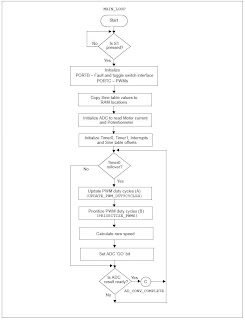The input section is replaced with a standard diode bridge rectifier. The output section has a 3-phase inverter bridge. The main difference from the previous scheme is the way the motor windings are connected to the inverter. One end of the main winding and start windings are connected to one half bridge each. The other ends are tied together and connected to the third half bridge, as shown in
Figure 5.
 With this drive topology, control becomes more efficient; however, the control algorithm becomes more complex. The voltages V a, V b and V c should be controlled to achieve the phase difference between the effective voltages across the main and start windings to have a 90 degree phase shift to each other. The turn ratio of the start winding to the main winding is defined by:
With this drive topology, control becomes more efficient; however, the control algorithm becomes more complex. The voltages V a, V b and V c should be controlled to achieve the phase difference between the effective voltages across the main and start windings to have a 90 degree phase shift to each other. The turn ratio of the start winding to the main winding is defined by: 
where a is the turn ratio, and VMAIN and VSTART are the effective voltage across the main winding and the start winding.
In order to have equal voltage stress on all devices, thus improving the device utilization and provide the maximum possible output voltage for a given DC bus voltage, all three inverter phase voltages are kept at the same amplitude as follows:  The effective voltage across the main and start winding is given as:
The effective voltage across the main and start winding is given as:

The voltages are shown in the phasor diagram in
Figure 6.

As seen in the phasor diagram in Figure 6, the voltages across phase A and phase B are out of phase, and the phase difference between phase A and phase C is q degrees. By applying basic trigonometry, q can be calculated by:

By applying the Pythagorean Theorem, the voltage vector V1 can be calculated as:

Because the turn ratio remains constant for a given motor, a can be a compile time option. With this, q and V1 can be precomputed for a given motor. This simplifies the run time calculation. Based on the phase angle, phase voltages Va, Vb and Vc can be calculated as:

Vdc is the DC bus voltage, and wt is the angular velocity of the electrical cycle. The direction of rotation can be easily controlled by adding or subtracting q in the Vc calculation.
Figure 7 shows the phase voltages V a, V b and V c, and
Figure 8 shows the effective voltages across the main winding (VMAIN) and the start winding (VSTART). Figure 8 also shows that the effective phase difference between the voltages is 90 degrees and the effective voltage ratio is a.
click to enlarge Fig.7

click to enlarge Fig.8





 With this drive topology, control becomes more efficient; however, the control algorithm becomes more complex. The voltages V a, V b and V c should be controlled to achieve the phase difference between the effective voltages across the main and start windings to have a 90 degree phase shift to each other. The turn ratio of the start winding to the main winding is defined by:
With this drive topology, control becomes more efficient; however, the control algorithm becomes more complex. The voltages V a, V b and V c should be controlled to achieve the phase difference between the effective voltages across the main and start windings to have a 90 degree phase shift to each other. The turn ratio of the start winding to the main winding is defined by: 
 The effective voltage across the main and start winding is given as:
The effective voltage across the main and start winding is given as:













